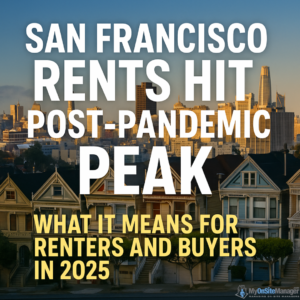San Francisco’s rental market is making headlines once again — this time, for reaching a significant milestone. As of March 2025, the city’s rental prices have rebounded to their pre-pandemic highs, signaling a strong recovery from the economic uncertainty of recent years.
But what does this mean for current renters, future tenants, and potential homebuyers? And how does this compare to other parts of the Bay Area and the nation as a whole?
Let’s take a closer look at what’s happening in the rental landscape of San Francisco and beyond.
A Return to High Rents: What the Numbers Say
According to recent data, the median rent for a one-bedroom apartment in San Francisco now sits at $3,200, reflecting a 10.3% increase year-over-year. For many, this signals the city’s continued recovery after pandemic-era rent drops — but it also reignites affordability concerns.
Renters across the city are feeling the pinch, especially as wages struggle to keep pace with housing costs. For context, this figure matches levels not seen since 2019, before COVID-19 reshaped how and where people live and work.
It’s Not Just San Francisco — Other Cities Are Feeling It Too
San Francisco isn’t alone in this rental resurgence. Across the U.S., rents in urban hubs are climbing. Take New York City, for instance — it saw a 6.4% year-over-year increase, also nearing its own all-time rent highs.
Here’s how national trends compare:
-
Nationwide median rent for a 1-bedroom: $1,524 (up 2.5%)
-
Nationwide median rent for a 2-bedroom: $1,905 (up 3.1%)
Although these national averages pale in comparison to San Francisco’s prices, they show a steady, upward trend — signaling a broader rental market shift.
Suburbs on the Rise: A Shift in Demand
Interestingly, it’s not just the big cities that are seeing a rent boom. In the Bay Area, suburbs are experiencing record-breaking increases as well. These areas, once considered more affordable alternatives to the city, are quickly catching up.
Check out these jaw-dropping year-over-year increases:
-
Campbell: +32.2%
-
Menlo Park: +24.3%
-
Sunnyvale: +23%
The reasons? A post-pandemic lifestyle shift, demand for more space, and a strong tech-driven job market. Remote work may have loosened ties to the city center, but it hasn’t removed demand — it’s simply redirected it.
What’s Fueling This Rental Surge?
Several key factors are at play:
1. Economic Recovery & In-Person Work Resumption
As tech companies and other employers push for hybrid or in-office work, employees are returning to urban cores, increasing demand for rentals close to workplaces.
2. Inflation Expectations
Consumer expectations for inflation are rising. The average household now anticipates a 6.2% price increase over the next year. Landlords often adjust rent based on inflation forecasts to protect their bottom line.
3. High Mortgage Rates
With interest rates still elevated, many would-be homebuyers are staying put in rentals, shrinking rental supply and intensifying competition.
4. Limited Housing Supply
Construction hasn’t caught up with demand, especially in dense urban areas like San Francisco. This imbalance continues to push prices higher.
Should You Rent or Buy?
It’s a tough call. A recent study suggests it could take over 30 years for buying a home in San Francisco to become more cost-effective than renting — assuming current market trends continue.
This is due to:
-
High property prices
-
Steep interest rates
-
Long-term cost projections favoring renting in the short to mid-term
In essence, while buying a home may build equity over time, the initial investment may not be worth it for many — especially if they don’t plan to stay in the area long-term.
What Can Renters and Buyers Do?
Here are a few practical takeaways:
For Renters:
-
Explore emerging neighborhoods or further suburbs for better value
-
Negotiate lease terms — some landlords may offer concessions (free parking, utilities, or a month free)
-
Consider co-living or roommates if flexibility allows
For Buyers:
-
Keep an eye on interest rate trends before committing
-
Look for off-market or pre-foreclosure deals
-
Consider buying in suburbs with growth potential for long-term value
Final Thoughts
San Francisco’s rent rebound paints a picture of a city regaining its economic rhythm — but also of a housing market that remains deeply challenging for many.
Whether you’re a long-time local, a newcomer, or someone considering a move to the Bay, it’s more important than ever to stay informed and strategic. As market conditions shift, understanding the “why” behind the numbers can help you make better housing decisions for your future.
Sources:

